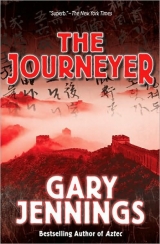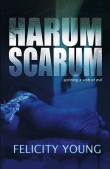
Текст книги "The Journeyer"
Автор книги: Gary Jennings
Жанр:
Исторические приключения
сообщить о нарушении
Текущая страница: 49 (всего у книги 78 страниц)
In one of the few lowland places we crossed in that region, we came to a village built entirely of zhu-gan, and furnished with it, and totally dependent on it. The village, called Chieh-chieh, sat in a wide valley, through which ran one of the innumerable rivers of that country, and the whole valley bottom was thick with groves of the zhu-gan, and Chieh-chieh looked as if it too had grown there. Its houses were all made of the golden cane. Their walls were composed of arm-thick stalks of it, stood up side by side and lashed together; thicker lengths of zhu-gan were the posts and columns that held up roofs of split-cane segments laid over-and-underlapping like curved tiles. Inside each house, the furniture of tables and couches and floor mats was woven of slender strips peeled from the zhu-gan, as also were things like boxes, bird cages and baskets.
Because the river was bordered by extensive marshes, Chieh-chieh was situated several li distant from it, but the river’s water was brought all that way through a pipe made of waist-thick canes joined end to end, and in the village square that water spilled into a trough made of half a log-sized zhu-gan. From the trough, the village boys and girls carried water to their cane-built homes in buckets and pots and bottles, all of which were joints of zhu-gan of various sizes. In the homes, the women used splinters of the cane for pins and needles, and the unraveled fiber of it for thread. The menfolk made from split lengths of the cane both their hunting bows and the arrows for them, and carried the arrows in a quiver that was only a big joint of zhu-gan. They used tree-sized stalks of the cane as the masts for their fishing boats and, with ropes braided of zhu-gan fibers, hung from those masts sails of lattice-worked zhu-gan strips. The village’s headman probably had little writing to do, but he did it with a pen made of cane strip, split at one end, and wrote on paper made from the pulp scraped from the soft interior walls of the cane, and kept his written scrolls in a vase-sized joint of zhu-gan.
When my escorts and I dined that night in Chieh-chieh, the meal was served in bowls that were halved joints of big zhu-gan, and the nimble tongs were slender sticks of zhu-gan, and the meal included—besides river fish fresh-caught with a zhu-gan fiber net and broiled over a fire of burning zhu-gan scraps—the soft-boiled and succulent shoots of new-sprouted zhu-gan, and some of the same shoots pickled for a condiment, and some more of them candied for a sweet. None of us visitors was ill or injured, but, if we had been, we might have been doctored with tang-zhu, which is a liquid that fills the hollow joints of the zhu-gan when it has just come to maturity, and that tang-zhu has many medicinal uses.
I learned all those things about the zhu-gan from Chieh-chieh’s elderly headman, one Wu. He was the only villager who spoke Mongol, and in consequence he and I sat up talking quite late, while my two escorts, one after the other, wearied of listening to us and went off to their allotted bedchambers. Old Wu and I were at last interrupted by a young woman coming into the cane-walled room where we sat on cane couches, to make what sounded like a whine of complaint.
“She wishes to know if you are never coming to bed,” said Wu. “This is the prime female of Chieh-chieh, chosen from all the others to make your night here memorable, and she is eager to get on with it.”
“Hospitable of her,” I said, and regarded her with speculation.
The people in that Land of the Four Rivers, men and women alike, wore clothing that was lumpy and shapeless: a hat like a sort of pod for the head, robes and wraps and shawls layered from shoulders to feet, clumsy boots with upturned toes. The body garments were all patterned in broad stripes of two different colors, and everybody in a village wore the same two colors, and the colors of each village were different—so a “foreigner” from the next village down the road could be instantly recognized—and the colors were always dark and dingy ones (in Chieh-chieh they were brown and gray) so they would not show the ingrained dirt of them. In the mountain communities, that costume made the people blend into their background, which may have been useful for hunting or hiding. But in Chieh-chieh, against the background of bright gold and green, it made them obtrusively unsightly.
Since the men and women were indistinguishably garbed, indistinguishably hairless of face, flat of features, ruddy-brown of complexion, they had to show—even for their own convenience, I would suppose—something to mark their sex. So the stripes of a woman’s garments went up and down, the stripes of a man’s from side to side. A real foreigner like myself, not immediately perceiving that subtle difference of costume, could only tell them apart when they took off their pod hats. The men could then be seen to have their heads shaven and a gold or silver ring in the left ear. The women had their hair twisted into a multitude of thin, spiky braids—to be specific, exactly one hundred and eight braids, that being the number of books in the Kandjur, the Buddhist scriptures, and these people being all Buddhists.
Since my journey that day had not been a punishing one, and since the prettiness of the cane-built village had relaxed and rested me, I was inclined to indulge my curiosity as to what other evidences of femininity might lurk beneath this young woman’s graceless garments. I noticed that she was wearing an ornament: a neck chain from which depended a fringe of jingling silver coins—and, assuming that they also numbered one hundred and eight, I said to old Wu:
“When you call her the village’s prime female, do you refer to her wealth or her piety?”
“Neither,” he said. “The coins attest to her female charms and desirability.”
“Indeed?” I said, and stared at her. The neck chain was attractive enough, but I could not see how it made herany more so.
“In this land, our young women compete,” he explained, “as to which of them can lie with the most men—those of their own village, or other villages, or casual passersby, or the men of trains traveling through —and require of each man a coin in token of the coupling. Clearly, the girl who amasses the most coins has attracted and satisfied the most men, and is preeminent among women.”
“You mean marked an outcast, surely.”
“I mean preeminent. When she finally is ready to marry and settle down, she can take her pick of husbands. Every eligible young man vies for her hand.”
“Her hand no doubt being the least used-up part of her,” I said, slightly scandalized. “In civilized lands, a man marries a virgin whom he knows is his alone.”
“That is all that canbe known of a virgin,” said old Wu, with a disparaging sniff. “A man wedding a virgin risks getting a fish less warm than the one you ate at dinner. A man wedding any of our women gets credentials of her desirability and experience and talents. He also gets, not incidentally, a fair dowry of coins. And this young lady is most eager now to add your coin to her string, for she has never had one from a Ferenghi.”
I was not averse to lying with nonvirgins, and it might have been instructive to lie with one who brought credentials to the encounter. But the young woman wasmost regrettably plain, and I did not much like being regarded as just one more of a string. So I mumbled some excuse about being on a pilgrimage, and bound by a vow of the Ferenghi religion. I gave her a coin anyway, as recompense for my spurning of her well-attested charms, and escaped to my bed. It was a bedstead woven of strips of zhu-gan and it was very comfortable, but it creaked all night, with just me alone in it, and must have waked the whole village if I had availed myself of Chieh-chieh’s prime female. So I decided that the zhu-gan cane, for all its marvelous usefulness to mankind, was not ideal for every human purpose.
2
MY escorts and I rode on, through the alternation of mountains, ravines and valleys, sometimes up on the stark heights of the Pillar Road, occasionally down in the bright zhu-gan lowlands. That terrain did not change noticeably, but we realized that we had reached the High Land of To-Bhot when the people we met began to greet us by uncovering their heads, scratching the right ear, rubbing the left hip, and sticking out their tongues at us. That absurd salute—signifying that the greeter intends to think, hear, do or speak no evil—was peculiar to the people called Drok and Bho. Actually, they were the same people, only the nomads were called Drok and the settled ones Bho. The herder-and-hunter Drok lived like the plains-dwelling Mongols, and might have been indistinguishable from them except for their style of tent, which was black instead of yellow and was not supported by an interior lattice, as was the yurtu. A Drok tent had its walls pegged to the ground and its top hung up by long ropes which ran over high poles propped some distance away, then down to ground pegs farther off. That gave the tent the appearance of a black karakurt spider, crouched among its skinny, high-kneed legs.
The farmer-and-merchant Bho, though they had settled in communities, lived even more uncomfortably than the nomad Drok. They had tucked their villages and towns into high cliff crannies, which required them to pile their houses one atop another and another. That was contrary to what I knew of the Buddhist religion, which holds that the human head is the residence of the soul, so that a mother will not even pat the head of her own child. Yet here were the Bho living in such a manner that everybody dumped his wastes and trash and excretions on his neighbor’s plot and rooftop, and often enough in his very hair. That custom of building as high up as possible, I learned, dated from some long-ago time when the Bho worshiped a god called Amnyi Machen, or “Old Man Great Peacock,” who was believed to live in the highest peaks, and everyone tried to reside close to the god.
But now all the Bho were Buddhists, so on top of every community was perched a lamasarai, called by its inhabitants the Pota-lá. (Lá meant mount, and Pota was the Bho pronunciation of Buddha. And I will not make ribald word-play on that fact, from the indecorous meaning of “pota” in the Venetian tongue. No one has any need to inventderisions of the Bho and their religion.) The Pota-la being the topmost and most populous building in every community, the result was that the priests and monks—here called lamas and trapas—excreted copiously on all their lay congregation downhill. I was to find that Buddhism, in its To-Bhot form of Potaism, was dismally degraded by even stranger lunacies.
A Bho town might look charming when we saw it from afar—say, across the landscape of the huge blue-and-yellow poppies unique to To-Bhot, and the “Pota’s hair” willow trees hung with yellow bloom, and the clear blue sky speckled pink and black with rose finches and ravens. Any cliffside town was a vertical jumble of cliff-colored houses, distinguishable from the cliff because they oozed smoke from their little windows—curiously shaped windows, wider at the top than at the bottom—and that clutter of houses was overtopped by the even more jumbled Pota-lá, all turrets and gilded roofs and promenades and outside staircases and varicolored pennants flapping in the breeze, and dark-robed trapas pacing sedately about the terraces. But when we got closer, what had appeared from a distance comely, serene, even holy of aspect, was revealed to be ugly, torpid and squalid.
The quaint little windows of the town’s residences were set only in the upper stories, to be above the ghastly mess and smell of the streets. The populace at first seemed to consist only of wandering goats and fowl and skulking yellow mastiffs, and the steep, narrow, twisty alleys were thick with droppings we assumed to be theirs. But then we would begin to meet people, and wish we had been satisfied with the cleaner animals, because when the people stuck out their tongues in greeting, we could see that their tongues were the only un-dirt-caked things about them. They wore robes as drab and grimy as had the people in the lowlands; if males and females wore differing patterns of the drabness and griminess, I could not discern them. There were very few men, and a great many women, but I could tell the sexes apart because the men took the trouble to open their long robes when they urinated in the street; the women simply squatted; they wore nothing under their outer robes, or I hoped they did not. Sometimes a larger than ordinary heap of dung in the street would stir feebly, and I would see that it was a human being laid out to die, usually a very old man or woman.
My Mongol escorts confided to me that the Bho, in former times, disposed of their old folks by eating their corpses—on the theory that the dead could wish no finer resting place than the guts of their own get—and had discontinued that practice only after Potaism became the prevailing religion, because the Pota-Buddha had frowned on the eating of meat. The only relic of the former custom was that families now conserved the skulls of their dead and made them into drinking bowls or little drums, so that the departed could still partake of holiday feasts and music making. Nowadays the Bho observed four other methods of sepulture. They burned the dead on mountaintops, or left them there for the birds, or they threw them into the rivers and ponds from which they got their drinking water, or they cut the corpses into pieces and fed them to dogs. The latter was the method most preferred, because that hastened the dissolution of the flesh, and until the old flesh was gone, its habitant soul was marooned in a sort of Purgatory between death here and rebirth elsewhere. The bodies of the poor were merely thrown to the packs of street curs, but the bodies of the rich were conveyed to special lamasarais which maintained kennels of sanctified mastiffs.
Those practices doubtless accounted for To-Bhot’s teeming population of scavenger vultures and ravens and magpies and dogs, but they also accounted for more humans’ dying than necessary. The dogs were so many that they were exceedingly liable to the canine madness, and in their fits they bit people as well as each other. More of the Bho were slain by the canine infection than by all the vile diseases engendered by their own squalor. Often, the heap in the street would be not just feebly stirring, but writhing and contorting and howling like a dog, in the terrible death agonies of that madness.
Because I had no wish to be bitten, and because I was on my way to war, I procured a bow and arrows and began to improve my aim and my arm by shooting every stray dog that came within range. That earned me black looks from the religious and the lay Potaists alike, who would rather that people die for no reason than that people should kill for good reason. However, since I carried the Khakhan’s plaque, no one dared to do more than scowl and mutter, and I became quite proficient with both the broad-head and narrow-head arrows, and I hope I effected some small improvement in that wretched land, but I doubt it. I doubt that anyone or anything could.
On our arrival in any Bho community, my escorts and I climbed as quickly as we could to the Pota-lá on top, where we honored visitors were always put up, it affording the best of local accommodations. That meant only that we did not get excreted on from above—though, if we had, it could not have made the rooms and the bedding and the food and the company much filthier. Before leaving Kithai, I had heard a Han gentleman quote a contemptuous saying of his people—that the three national products of To-Bhot were lamas, women and dogs—and now I believed him. It was apparent that the disproportionate number of women in the town down the hill was owing to the fact that at least a third of their men had taken holy orders and residence in some lamasarai. Having seen the Bho women, I could not much fault the Bho men for having fled, but I did think that they might have fled to some existence better than a living embalmment.
Entering a Pota-lá courtyard, we were greeted first by the creaking, fluttering and clattering of prayer mills, prayer flags and prayer bones, then by the roars and snarls of the savage yellow To-Bhot mastiffs, which in those places were at least kept chained to the walls. Also along those walls, in every least niche, there was incense or a juniper sprig burning, but its perfume was insufficient to mask the overall miasma of yak-dung fires, putrid yak butter and unwashed religiosity. After meeting the noise and the stench, we met a number of monks and a few priests plodding majestically toward us, each of them holding out across his palms the khata, the pale blue silk scarf with which (instead of his tongue) every upper-class Bho salutes an equal or superior. They addressed me as Kungö, which means “Highness,” and I properly addressed each lama as Kundün, “Presence,” and each trapa as Rimpoche, “Treasured One”—though it nearly gagged me to utter such honorific lies. I could see nothing treasurable about any of them. Their robes, which had first seemed to be of ecclesiastically sedate colors, could be seen up close to have been originally bright red, and were dark only from years of accumulated dirt. Their faces, hands and shaved heads were blotched with a brown plant-sap they daubed on their various skin diseases, and their chins and chops were shiny with the yak butter that drenched everything they ate.
In the matter of foods at the lamasarais, we were most often served Potaist vegetable meals, of course—tsampa, boiled nettles, ferns—and a strange, stringy, slimy, bright-pink stalk of some plant unknown to me. I suspect that the holy men ate it only because it made one’s urine pink for days afterward, and that effluent trickle no doubt awed the people downhill of the lamasarai. But the Bho had a peculiar selectivity about the Potaist injunction against eating meat. They would not slaughter domestic fowl or cattle, but would allow the slaying of game pheasants and antelope. So the lamas and trapas sometimes provided those venisons for us, as an excuse for them to enjoy the meats as well. (I am not unjustly scoffing at their hypocrite austerities. One lama was introduced to me as “a most holy of holy men” because he subsisted on “absolutely no nourishment except a few bowls of cha a day.” Out of skeptic curiosity, I kept a close eye on that lama, and eventually caught him in the preparation of his mealtime bowl. It was not cha leaves he used in the steeping, but cha-like shreds of dried meat.)
However un-Potaistly lavish our meals sometimes were, they were never very elegant. We being honored guests, we were always seated to dine in the Pota-lá’s “chanting hall,” so we had the mealtime entertainment of several dozen trapas dolefully chanting while they thumped skull drums and rattled prayer bones. Among the serving platters and eating bowls, the banquet table bore an array of spittoons, and the holy men used them to the point of overflow. All about the dark hall stood statues of the Pota and his numerous disciple godlings and the numerous adversary demons, and every one of them was visible even in the gloom, because it gleamed with its slathering of yak butter. Where we Christians would light a candle to a saint, or perhaps leave with him a taolèta, it was the Bho’s practice to smear their idols with yak butter, and the thick and ancient layers reeked of rancid decay. Whether the Pota and the other images were gratified by that, I do not know, but I can attest that the local vermin were. Even when the hall was full of noisy diners and chanters, I could hear the squeaks and snickers of mice and rats as they—plus cockroaches, centipedes and God knows what else—scurried foraging up and down the statues. Most nauseating of all, we and our dinner hosts always sat on what I at first took to be a low dais built up above the floor level. It felt rather spongy under me, so I furtively investigated to see what it was made of—and discovered that we were seated atop nothing but a mound of compacted food droppings, the detritus of decades or maybe centuries of the holy men’s slovenly drool-ings and slobberings of their meals.
When their mouths were not masticating or otherwise occupied, the holy men chanted almost continuously, in concert at the top of their lungs, in solitude under their breaths. One chant went like this: “Lha so so, khi ho ho,” which meant more or less, “Come gods, begone demons!” A shorter one went like this: “Lha gyelo,” meaning “The gods are victorious!” But the chant that was heard most often and interminably and everywhere in To-Bhot went like this: “Om mani pémé hum.” The opening and closing noises of it were always intoned in a drawn-out manner, so: “O-o-o-om” and “Hu-u-u-um,” and they constituted just a sort of “amen.” The other two words meant, literally, “the jewel in the lotus,” in the same sense that those terms are used in the Han lexicon of sex. In other words, the holy men were chanting, “Amen, the male organ is inside the female’s! Amen!”
Now, one of the Han religions prevailing back in Kithai, the one they call Tao, “the Way,” has an unashamed connection with sex. In Taoism, the male essence is called yang and the female’s is yin, and everything else in the universe—whether material, intangible, spiritual, whatever—is regarded as being either yang or yin, hence totally discrete and opposite (as men and women are) or complementary and necessary to each other (as men and women are). Thus active things are called yang, passive ones yin. Heat and cold, the heavens and the earth, sun and moon, light and darkness, fire and water, they are all respectively yang and yin, or, as anyone can recognize, inextricably yang-yin. At the most basic level of human behavior, when a man couples with a woman and absorbs her female yin by means of his male yang, he is not in any sense tinged with effeminacy, but becomes more of a complete man,stronger, more alive, more aware, more worthwhile. And just so, the woman becomes more of a woman by accepting his yang with her yin. From that elementary foundation, Tao proceeds up to metaphysical heights and abstractions that I cannot pretend to grasp.
It may be that some Han Taoist, wandering into To-Bhot long ago, when the natives still worshiped the Old Peacock, kindly tried to explain to them his amiable religion. The Bho could hardly have misunderstood the universal act of putting male organ into female—or jewel into lotus, as the Han would have expressed it—or mani into pémé, in their language. But such oafs would have been baffled by the higher significances of yang and yin, so all they ever retained of Tao was that preposterous chant of “Om mani pémé hum.” Still, not even the Bho could have built much of a religion on a prayer that had no loftier meaning than “Amen, stick it in her! Amen!” So, as they later and gradually adopted Buddhism from India, they must have adapted the chant to fit that religion. All they had to do was construe the “jewel” as Buddha, or Pota, because he is so often portrayed as sitting in meditation on a large lotus blossom. So the chant came to mean something like “Amen, Pota is in his place! Amen!” And then, no doubt, some later lamas—in the way that self-appointed sages always complicate even the purest faith with their unsolicited commentaries and interpretations—decided to festoon the simple chant with more abstruse aspects. So they decreed that the word mani (jewel, male genitals, Pota) would henceforth signify The Means, and the word pémé (lotus, female genitals, Pota’s place) would henceforth refer to Nirvana. Thus the chant became a prayer beseeching The Means to achieve that Nirvana oblivion which Potaists deem the highest end of life: “Amen, blot me out! Amen!”
Certainly, Potaism no longer had any laudable connection with sexual relations between men and women, because at least one of every three Bho males, at puberty or even younger, fled from the prospect of ever having to endure sex with any Bho female, and took the red robe of religion. So far as I could tell, that vow of celibacy was the only qualification necessary for entrance into a Pota-lá and eventual elevation through the ascending degrees of monkhood and priesthood. The chabis, or novices, were given nothing like a secular education or seminary instruction, and I encountered only three or four of the oldest and highest-grade lamas who could even read and write the “Om mani peme hum,” let alone the one hundred and eight books of the Kandjur scriptures, let alone the two hundred and twenty-five Tengyur books of commentary on the Kandjur. In speaking of the holy men’s celibacy, however, I should rightly have said celibacy in regard to females. Many of the lamas and trapas flagrantly flaunted their amorousness toward each other, to leave no doubt that they had forsworn sordid, ordinary, normal sex.
Potaism, however it developed, was a religion demanding only sheer quantity of devotion, not any quality of it. By that I mean a seeker of oblivion simply had to repeat “Om mani pémé hum” enough timesduring his life and he expected that would take him to Nirvana when he died. He did not even have to speak the words, or repeat them in any way requiring his own volition. I have mentioned prayer mills; they were everywhere in the lamasarais, and in every house, and even to be found standing in empty countryside. They were drumlike cylinders within which were wound paper scrolls on which the mani chant was written. A man had only to give the cylinder a spin with his hand and those “repetitions” of the prayer counted to his credit. Sometimes he rigged it like a waterwheel, so that a stream or cascade kept it turning and praying constantly. Or he could hoist a flag inscribed with the prayer, or a whole line of them—those were far more frequently to be seen in To-Bhot than any lines of washing hung out—and every flap the wind gave every flag was credited to him. Or he could run his hand along a line of dangling sheep shoulder blades, each bone inscribed with the mani, strung like wind chimes, and they prayed for him as long as they went on clattering.
I once came upon a trapa crouched beside a creek, flinging into it and hauling out again a tile attached to a string. He had been doing that, he said, all his adult life, and would go on doing it until he died.
“Doing what?” I asked, thinking that perhaps, in some idiotic Bho way, he was trying to emulate San Piero as a fisher of souls. The monk showed me his tile; it was engraved with the mani prayer, in the fashion of a yin seal. He explained that he was “imprinting” the prayer on the running water, stamping it there over and over again, and he was accruing piety with every invisible “impression.”
Another time, in a Pota-lá courtyard, I saw two trapas come to violent blows because one of them had given a twirl to a prayer mill and then, glancing back as he walked on, saw a brother monk stop the mill and spin it in the other direction to pray for him.
Atop one of the major towns on our way was an especially large lamasarai, and there I made bold to seek audience of its venerable and filthy and sap-daubed Grand Lama.
“Presence,” I addressed the old abbot, “I seldom observe anything going on in any Pota-lá that looks like ecclesiastical activity. Aside from twirling prayer mills or shaking prayer bones, what exactly are your religious duties?”
In a voice like the rustle of far-off leaves, he said, “I sit in my cell, my son Highness, or sometimes in a remote cave, or on a lonely mountaintop, and I meditate.”
“Meditate on what, Presence?”
“On my once having laid eyes on the Kian-gan Kundün.”
“And what would that be?”
“The Sovereign Presence, the Holiest of Lamas, he who is an actual reincarnation of the Pota. He resides in Lha-Ssa, the City of the Gods, a long, long journey from here, where the people are building for him a Pota-lá worthy of his occupancy. They have been building on it for more than six hundred years now, but they expect to have it completed in only four or five hundred more. The Holiest will be pleased to grace it with his Sovereign Presence, for it will be a palace most magnificent when it is finally done.”
“Are you saying, Presence, that this Kian-gan Kundün has been alive and waiting for six hundred years? And he will still be alive when the palace is finished?”
“Assuredly so, my son Highness. Of course you, being ch’hipa—outside the belief—might not see him so. His corporeal integument dies from time to time, and then his lamas must cast about the land and find the infant boy into whom his soul has transmigrated. So the Sovereign Presence looks physically different, from lifetime to lifetime. But we nang-pa—we within the belief—we know him to be always the same Holiest of Lamas, and the Pota reincarnated.”
It seemed to me somewhat unfair that the Pota, having created and prescribed Nirvana for his devotees, evidently never got to rest obliviously there himself, but had to keep on being fetched back to Lha-Ssa, a town doubtless as awful as any other in To-Bhot. But I refrained from remarking on that, and gently prompted the old abbot:
“So you made the far journey to Lha-Ssa, and you saw the Holiest of Lamas … ?”
“Yes, my son Highness, and that event has occupied my meditations and contemplations and devotions ever since. You may not believe this, but the Holiest actually opened his own rheumy old eyes and looked at me.” He put on a wrinkled smile of rapt reminiscence. “I think, if the Holiest had not been then so ancient and approaching his next transmigration, he might almost have summoned up his strength and spoken to me.”
“You and he only looked at each other? And that has furnished you with meat for meditation ever since?”
“Ever since. Just that one bleared glance from the Holiest was the commencement of my wisdom. Forty-eight years ago, that was.”








